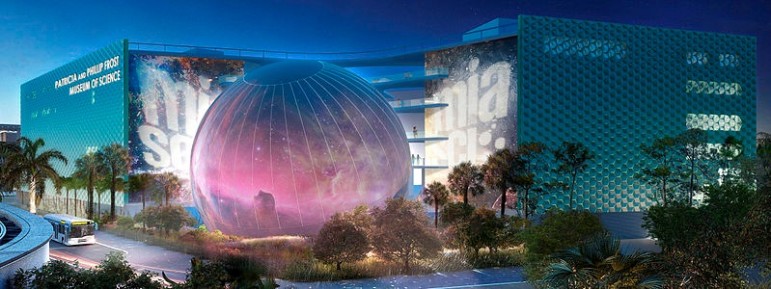
While most Miami-Dade residents would likely agree that a world-class science museum will ultimately prove to be an asset to their region, many are unhappy about how much of the tab they’ve had to pick up for the new Patricia and Philip Frost Museum of Science. Especially since last week, when county commissioners voted 12-1 to approve $49 million in tax dollars to allow construction of the cash-strapped nonprofit museum to continue, as reported by Doug Hanks in the Miami Herald. That’s on top of $165 million in public funds already spent on the project from a $2.9 billion bond referendum that county voters approved in 2004.
The county will borrow the funds for the upfront construction grant, which will be repaid over time with hotel taxes. This grant (and the interest the county will pay on the loan) will cancel out $80 million in operating funds that Miami-Dade County had planned to contribute at a rate of $4 million a year for the first 20 years of the new facility’s existence. To date, no explanation has been offered for how the museum might make up the extra $4 million a year—perhaps because all the energy remains focused on completing construction and opening the doors this November.
As NPQ reported in February, construction was at risk of being stalled when it became known that the museum had spent all of its available funds and had not been able to secure a large enough bank loan to cover the rest of the work. When construction began in 2012, the new museum was expected to cost $275 million. Over time, this mushroomed to $305 million. More recently, cuts of about $20 million have been made, eliminating some features, especially in the outdoor spaces, although museum officials hope that in time those will be funded and completed. Philip and Patricia Frost, whose generous support of the project secured the naming rights, provided a bridge loan for an unspecified amount to allow construction to continue over the last two months, as county officials worked through details of the rescue plan ahead of last week’s vote.
Mayor Carlos Gimenez, who is running for re-election later this year, said before the vote, “We can’t just sit back and watch it fail. We owe this museum to the future generations of Miamians.” And while most commissioners agreed to support the rescue plan, not all did so with great confidence. The tone of their comments suggested that they didn’t see any other option but to keep the project moving forward. No one questioned the value of the museum itself or the impact it will likely have as an educational and inspirational resource for Miami’s young people or as a draw for tourists to the city’s Museum Park. But many wondered how the museum’s leadership could have fallen so short of their fundraising goals that the project had to be bailed out with public funds.
On the eve of last week’s vote, the Miami-Dade Inspector General’s office issued a report that raised a number of questions about the lack of oversight of how the public funds were being spent and how far behind the museum was in raising private funds. Hanks covered this report, which supports the $49 million grant to finish construction, noting that to abandon the project at this stage would have resulted in the County seeing “a degradation of its investment.” The report also referenced the likely impact on the museum of losing that $20 million-a-year subsidy for operating costs. As Hanks wrote:
The OIG’s office said it was “concerned” about the reliance of forecasts from a bullish museum consultant’s report that predicts surges in attendance, membership and other revenue once the Frost moves from its longstanding home in Coconut Grove to downtown Miami’s new Museum Park.
Sign up for our free newsletters
Subscribe to NPQ's newsletters to have our top stories delivered directly to your inbox.
By signing up, you agree to our privacy policy and terms of use, and to receive messages from NPQ and our partners.
The “County must be vigilant as to the potential impact of any variance in the factors used to determine the Museum’s operating forecast,” the report stated.
In a follow-up editorial, Miami Herald reporter and editor Fabiola Santiago supported the $49 million rescue plan and applauded “all who came together to push the reset button.” But she raised important questions about the need for additional private funds, as well as the need for transparency with so much public money at stake.
Will the rest of South Florida back them up by purchasing memberships and stepping up donations now that construction money has been secured? That remains to be seen, but I’ve seen support follow public funding. This town loves a winner—and the Frost Science will become another architectural crown jewel at Museum Park when it hopefully opens this fall.
Having said that, there’s no question that the Frost Science debacle must drive home the point that these quasi-public institutions operating with large infusions of government funds must be more open to public scrutiny, no excuses.
For months, the Frost leadership misled media, underplaying the precarious state of finances and hiding the shenanigans of their since-overhauled board of directors and fired construction company. When it all came to light, people felt that, once more, taxpayers learned too late that an institution using public funds is in trouble. No wonder there’s no trust.
No trust—and still, very few trustees. As a condition for the bridge loan provided by the Frosts and the County’s willingness to offer a rescue plan, those holding the purse strings insisted that the museum’s board would have to be “reconstituted.” The only trustee allowed to retain her seat was Patricia Frost—who may have done more than her fair share as a donor, but there’s a lot more to governance than writing checks. Her husband joined the new board, as did two other wealthy Miami businessmen, Cesar Alvarez (who previously served on the museum’s board) and Richard Pfenniger. As for the “shenanigans of their since-overhauled board of directors”—unless important information is missing from the public record, the shenanigans seem to consist of having caused embarrassment to the Frosts by not having donated or raised enough private money to avoid the county rescue. When the board “reconstitution” was announced in February, it was stated that new trustees would be added to lend additional “fundraising firepower” to the museum, and that Miami-Dade officials would also serve on the board, reflecting the need to provide additional oversight for the county’s significant investment in the project. If any additional trustees have been named, the website does not mention them. Only four trustees are listed, with both a Community Leadership Board and Scientific Advisory Board “to be announced.” So while they are clamoring for better stewardship of the museum’s budget and better oversight of the county’s investment, Miami-Dade officials and residents also ought to be insisting on a diverse, governance-minded board that will provide strategic leadership and will continue to serve the mission of this nonprofit science museum long after all the naming rights have been sold.—Eileen Cunniffe












